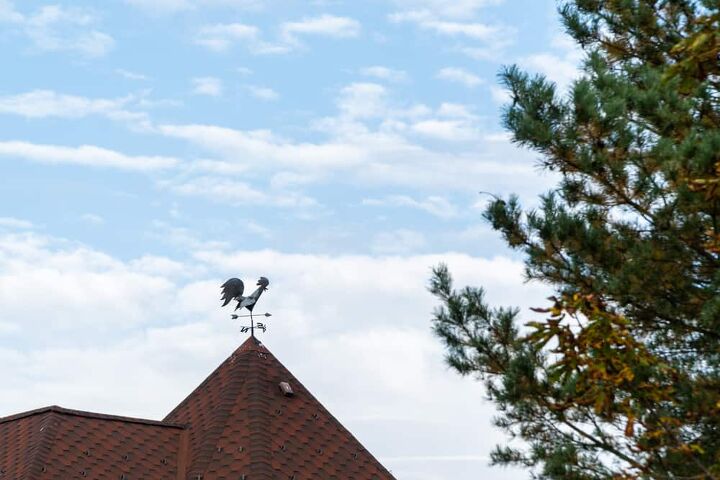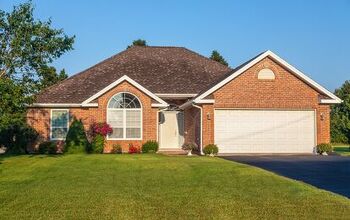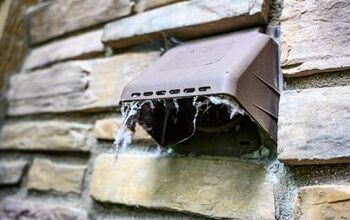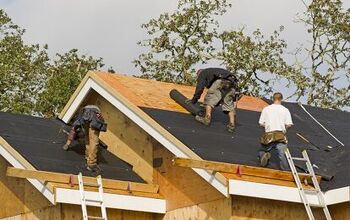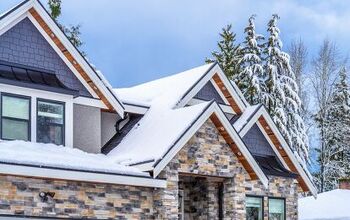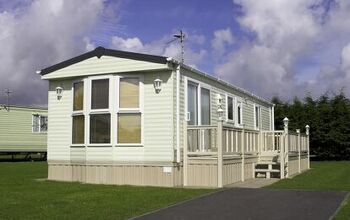How Much Wind Can A Roof Withstand? (Find Out Now!)

If you live in an area where severe weather is prevalent, your roof should be your top priority. When choosing a new roof for your home, you want to make sure it can withstand high winds. Before making your decision, research the best roof for you and your needs.
In today’s age, most modern shingle roofs can withstand 90 mile-per-hour winds. However, some roofing products are available for hurricane and tornado-prone areas that can withstand winds up to 150 miles-per-hour.
Do You Need Roofing Repair Services?
Get free, zero-commitment quotes from pro contractors near you.

A Closer Look at the Wind Uplift Rating
Wind uplift is the suction created by wind forces as air moves parallel to the roof’s surface. When a gust of wind meets a structure’s side, the air is pushed upward across the roof. This creates a pressure differential.
The air pressure on top of the roof is less than the air pressure below the roof, forming a suction. This suction, or uplift, pulls at the roof panels, so the faster the wind, the more forceful the uplift. In extreme winds, uplift can pull panels or shingles off buildings or homes.
Wind Uplift Rating: Risk Categories
Engineers use several factors when calculating wind uplift.
The first factor is the building category identifying the level of risk to human life should the roof fail.
I. A building that represents a low risk to human life in the event of failure, such as a storage building
II. Any building not covered by categories I, III, or IV
III. Buildings representing a substantial risk to human life, such as a school or arena
IV. Buildings designated as essential facilities such as emergency shelters
The second factor engineers use is a building’s position in relation to a nearby structure. They take this into account as the structure could cause the wind to change direction or speed.
Other factors that engineers consider include circumstances that can worsen or diminish wind effects or disrupt normal airflows.
- Large, open structures can make wind effects worse.
- Low walls can reduce the impact of wind effects.
- Roofs with unusual geometric surfaces may worsen or reduce wind effects depending on their design.
- Adjacent structures with extreme geometric designs may disrupt normal wind flow.
- Roof additions, such as tilted solar panels, may affect wind uplift.
The engineer then uses the building category, position, and other considerations to design wind uplift values.
Wind Uplift Rating: Rating Bodies
Rating systems are an attempt to show how well a roof will withstand wind uplift.
Underwriter Laboratories UL 580 Rating
The UL 580 rating is a well-respected test used since 1973. A 10×10 roofing material sample is installed on a test platform and subjected to uplift pressure for five minutes. The sample is also subjected to oscillating pressure in 10-second intervals over one hour.
The results determine the class of roofing.
- Class 30 – resists nominal static pressure of 30 psf and range of oscillating pressure between 22 and 42 psf, wind uplift pressure
- Class 60 – resists nominal static pressure of 60 psf and range of oscillating pressure between 44 and 83 psf
- Class 90 – resists nominal static pressure of 90 psf and range of oscillating pressure between 66 and 90 psf
The test doesn’t determine the failure rate in winds or rinds rapidly changing speed and direction. It also does not show the failure rate of the anchors used in the construction.
ASTM E 1592
ASTM E 1952 tests both panels and anchors. A five-panel sample with intermediate purlin support at various intervals covering several spans is subject to pressure from underneath. This pressure simulates wind load, and the panel edges move freely along the edges.
The pressure shows failures that develop slowly, such as seam separations and how a roof performs under wind pressure. This test continues until panels fail to determine the ultimate uplift capacity.
FM Global Standard 4471
Factory Mutual Global is not a governing body code but rather an insurance company. A group of in-house engineers conducts and writes its standard, but it has no control over the buildings it insures.
How Much Wind Different Types of Roofs Can Handle
Different types of roofs can handle severe winds better than others. Before choosing a roof for your home, review each material type.
Asphalt Shingles
Asphalt shingles are most common in the United States because they’re effective in most environmental conditions. Quality asphalt shingles should pass the ASTM D3161, Class F, or wind resistance of 110 miles-per-hour. They should also pass ASTM D7158, Class H, or wind resistance of 150 miles-per-hour.
Upfront costs for asphalt shingles are low, but you should replace them every 20 or so years. If you live in more severe weather-prone areas, you may need to replace them more often.
Clay and Concrete Shingles
Clay and concrete roof tiles can withstand damage from tornadoes, hurricanes, or winds up to 125 miles-per-hour. These shingles are great in warm, dry climates, but they require extra support to bear their weight. They are more likely to break when walked on, so try to avoid this as much as possible.
Metal
Metal roofing can be noisy during rainstorms and may dent from hail, but it excels at resisting high winds. They have a 140 mile-per-hour wind rating, and some can withstand gusts up to 180 miles-per-hour. Metal roofs typically last about 60 years, but corrosion also varies by material.
Stone-Coated Steel Shingles
Stone-coated steel roofs are interlocking panels mimicking slate, clay, or shingles. They can resist damage caused by heavy rains as well as resist winds of 120 miles-per-hour. They can also handle uplifting, hail, and freeze-thaw cycles.
They’re an economical and effective choice for wet and windy regions in addition to areas prone to wildfires. Some stone-coated steel roofs feature warranties for the lifetime of the house.
Wood Shake Shingles
Cedar shakes have high wind resistance properties when properly installed. When adequately maintained, they can withstand winds of up to 245 miles-per-hour. There are shakes and shingles available in Class 3 and 4 impact ratings.
Does Your Roof Have Wind Damage? Here’s What to Look For
If your home has experienced winds of 45 miles-per-hour or higher, you should take a look outside of your home. Look at your roof for any signs of wind damage. Signs of wind damage include loose or missing shingles, damaged chimneys, granule loss, damaged soffit or fascia, and indoor leaks.
Spots of Granules Missing from Shingles
Hail and wind can cause granules, or the sandpaper-like part of the shingle, to come loose. To determine if you have missing granules, check your gutters, as they tend to pile up there first.
Peeling Shingles
Edges and pressure points of the roof are most likely to sustain wind damage. If you notice curling shingles or shingles beginning to peel, contact a professional. Shingles keep out water, so if they’re loose, your roof is vulnerable to water damage.
Shingles Missing from the Roof
Missing shingles is one of the easiest ways to determine if you have wind damage to your roof. If you find shingles in your yard or around your home, you will want to have someone check it out. Strong winds can rip shingles off your roof, leaving it completely vulnerable.
Cracks or Tears in a Rubber Roof
If you have a flat roof, wind can lift the material or rip it away, hurting the integrity of the covering. If you have a flat roof, be aware of missing pieces or tears in the material.
Damaged Soffit or Fascia
Wind can cause cracks, loose or bent areas, or even blow off loose fascia. Soffit and fascia keep water away from the roof and reduce the chances of leaks. When they are damaged, they can open your home to water damage as well as pests.
Damaged Chimney
Check out your chimney after severe winds. If it looks crooked, this should raise a red flag to a bigger problem. Sometimes there can be missing spots or lagging, breaking the sealing around the chimney and letting in water.
Leaks and Indoor Signs of Roof Damage
While you may not think to look inside of your home for roof damage, you may find signs of leakage. If you see discoloration, wet spots, or peeling paint, there’s a good chance your roof is leaking.
Do You Need Roofing Repair Services?
Get free, zero-commitment quotes from pro contractors near you.

Related Questions
What are some good ways to reinforce a roof?
If you live in areas of severe weather, you want to make sure that your roof is in good shape. Properly constructed roofs have trusses and hurricane tie-downs, as well as other necessities, to withstand high winds. However, there are some do-it-yourself measures that you can take. To reinforce the trusses, apply construction adhesive along the edge of the truss to strengthen the connection to the roof deck. You can also stiffen the trusses by joining them with 2x4s from one end of the house to the other. Brace gable ends with diagonal 2x4s for extra strength.In addition to these reinforcements, you can also take simpler measures before a severe storm. Clean out the gutters and check for loose or damaged shingles. These are simple steps to ensure your roof is ready for any storm.
Do roof warranties typically cover wind damage?
A typical roof warranty will not cover wind damage. Instead, the manufacturer’s warranty covers the roof against defects in the materials. Alternatively, the roofing contractor’s warranty covers workmanship errors by the installing roofing contractor.However, a roof warranty will not cover the cost of a leak repair if natural disasters cause the issue. This includes fire, lightning, wind damage, hail, or earthquakes. It also does not cover negligent acts like misuse, vandalism, or loss of integrity of the structure.Before agreeing to a warranty, be sure that your roof is covered should something happen that’s out of your control.

Stacy Randall is a wife, mother, and freelance writer from NOLA that has always had a love for DIY projects, home organization, and making spaces beautiful. Together with her husband, she has been spending the last several years lovingly renovating her grandparent's former home, making it their own and learning a lot about life along the way.
More by Stacy Randall



